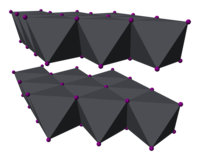
Photo from wikipedia
Atomic layer deposition (ALD) enables the deposition of numerous materials in thin film form, yet there are no ALD processes for metal iodides. Herein, we demonstrate an ALD process for… Click to show full abstract
Atomic layer deposition (ALD) enables the deposition of numerous materials in thin film form, yet there are no ALD processes for metal iodides. Herein, we demonstrate an ALD process for PbI2, a metal iodide with a two-dimensional (2D) structure that has applications in areas such as photodetection and photovoltaics. This process uses lead silylamide Pb(btsa)2 and SnI4 as precursors and works at temperatures below 90 °C, on a variety of starting surfaces and substrates such as polymers, metals, metal sulfides, and oxides. The starting surface defines the crystalline texture and morphology of the PbI2 films. Rough substrates yield porous PbI2 films with randomly oriented 2D layers, whereas smooth substrates yield dense films with 2D layers parallel to the substrate surface. Exposure to light increases conductivity of the ALD PbI2 films which enables their use in photodetectors. The films can be converted into a CH3NH3PbI3 halide perovskite, an important solar cell absorber material. For various applications...
Journal Title: Chemistry of Materials
Year Published: 2019
Link to full text (if available)
Share on Social Media: Sign Up to like & get
recommendations!